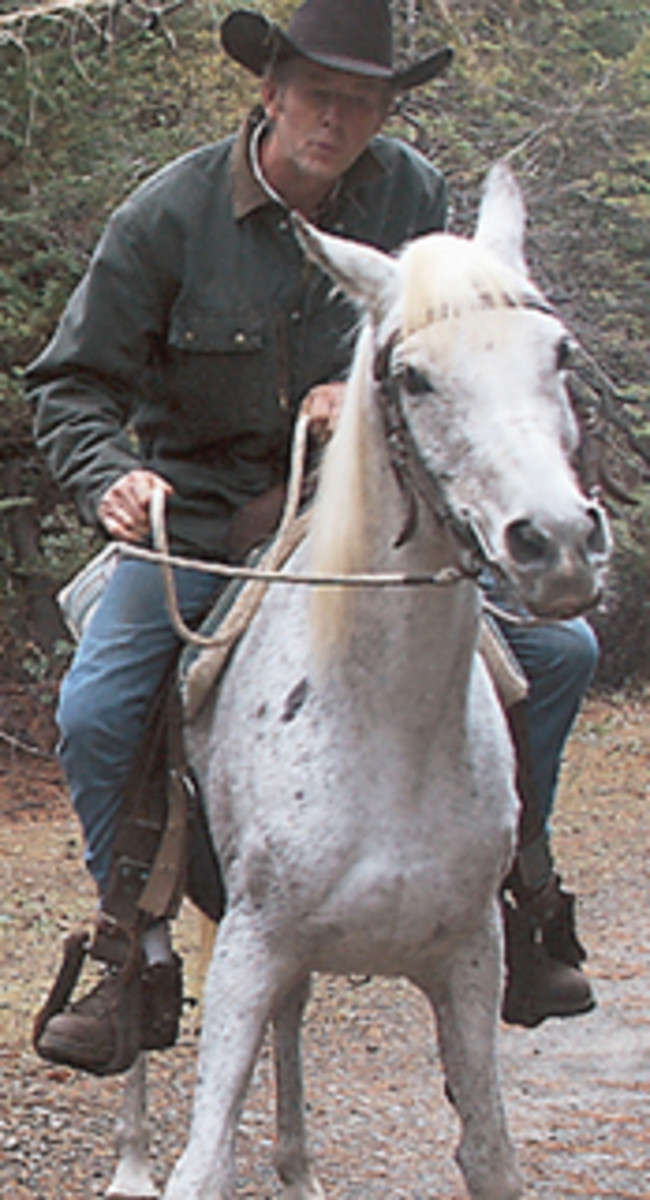
Fear on the trail involves both the horse and rider. Your horse jumps after seeing an object. You react by gripping with your legs, pulling back on your reins, or both. When you, as your horse’s “herd leader,” react this way, it reinforces your horse’s fear and a “wreck” is on.
“The more emotional and physical control that we have over ourselves and the less reactive we become to our horses, the more confidence that builds in the relationship,” notes Vallerie Sweeton, a riding instructor and trainer for Horses of Hope in Baxter Springs, Kansas.
A preacher once told Sweeton that it’s better to be like a thermostat in control of the atmosphere around you than a thermometer that reacts to the atmosphere.
Larry Levrets, a Bandon, Oregon, horse trainer, says that you give your horse confidence. He spends hours training in the woods leading and exposing horses to trails and fear objects. In a fear situation, he speaks to horses in a soft, kind voice. “The horse is the best teacher of them all, so pay attention to him,” he says.
Here, both Levrets and Sweeton explore the interaction of horse and human fear. In five potentially fearful situations, Levrets provides the horse’s viewpoint, while Sweeton provides the rider’s thoughts. Each also offers advice on how to remedy each situation, so both you and your mount can become more at ease-and safe-on the trail.
Brush Pile
Your horse’s view: Your horse is a prey animal with a finely honed flight instinct that helped his ancestors survive in the wild. That pile of brush could pose a threat to him. A predator could be hiding behind it, ready to leap out and attack. His instinct tells him to flee far from the threat, then turn around to reassess that threat from a safe distance.
Horse-trainer’s remedy: Spooking hurts more riders than any other way. To help your horse overcome his fear of brush, first outfit him in a saddle, halter, and lead rope. Carry the bridle over your shoulder. Lead him to the brush pile, and send him in a circle in both directions. Then lead him around the pile many times to show him it’s safe. Speak to him in a soft, kind voice. When he appears calm on the lead rope, put on the bridle, and ride him around the brush pile.
Rider’s view: I’m monitoring my mare’s reactions, but I’m also aware of myself. When you’re tense, you breathe shallowly or hold your breath, which affects your entire body. If you also lean forward on your toes, you tell your horse, “My herd leader is scared of this threat, too. It must be dangerous.” Monitor your breathing, and stay as relaxed as possible to help your horse relax.
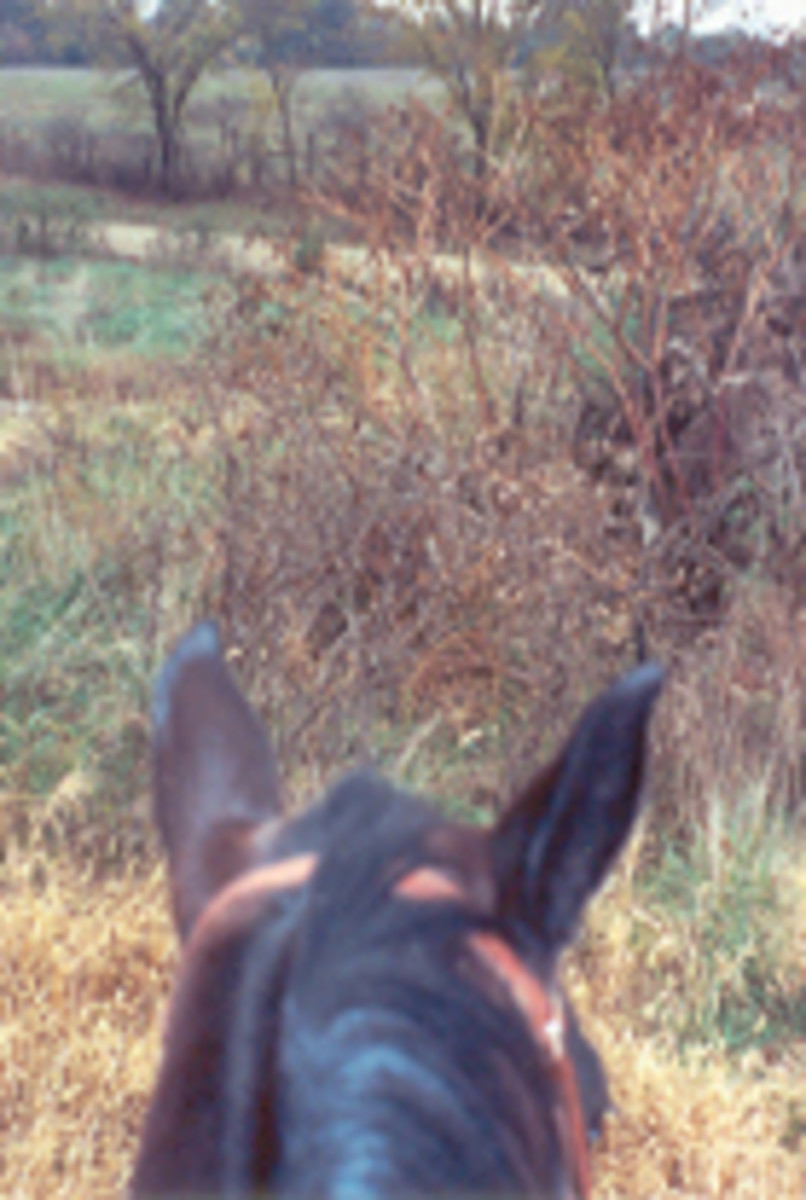
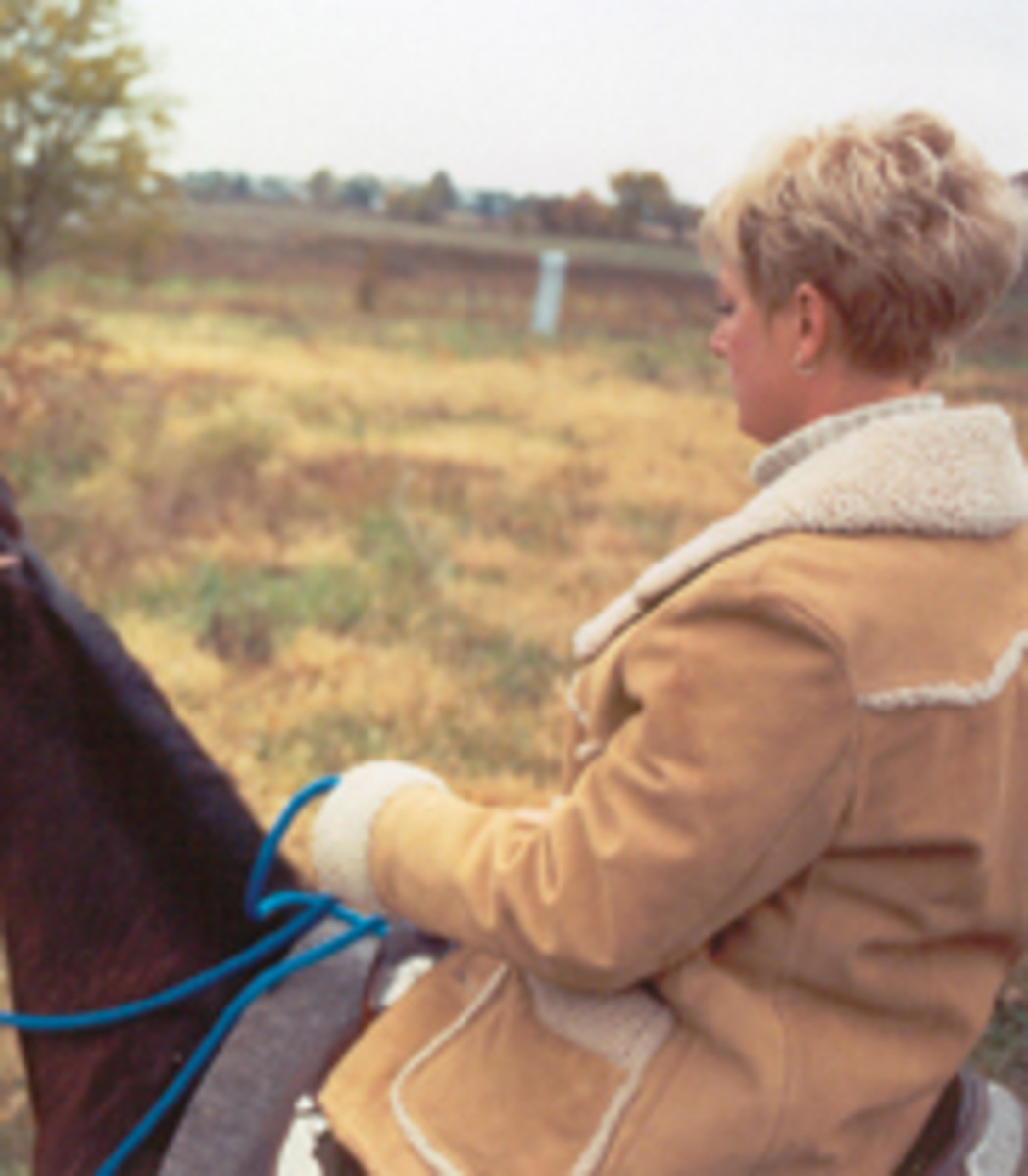
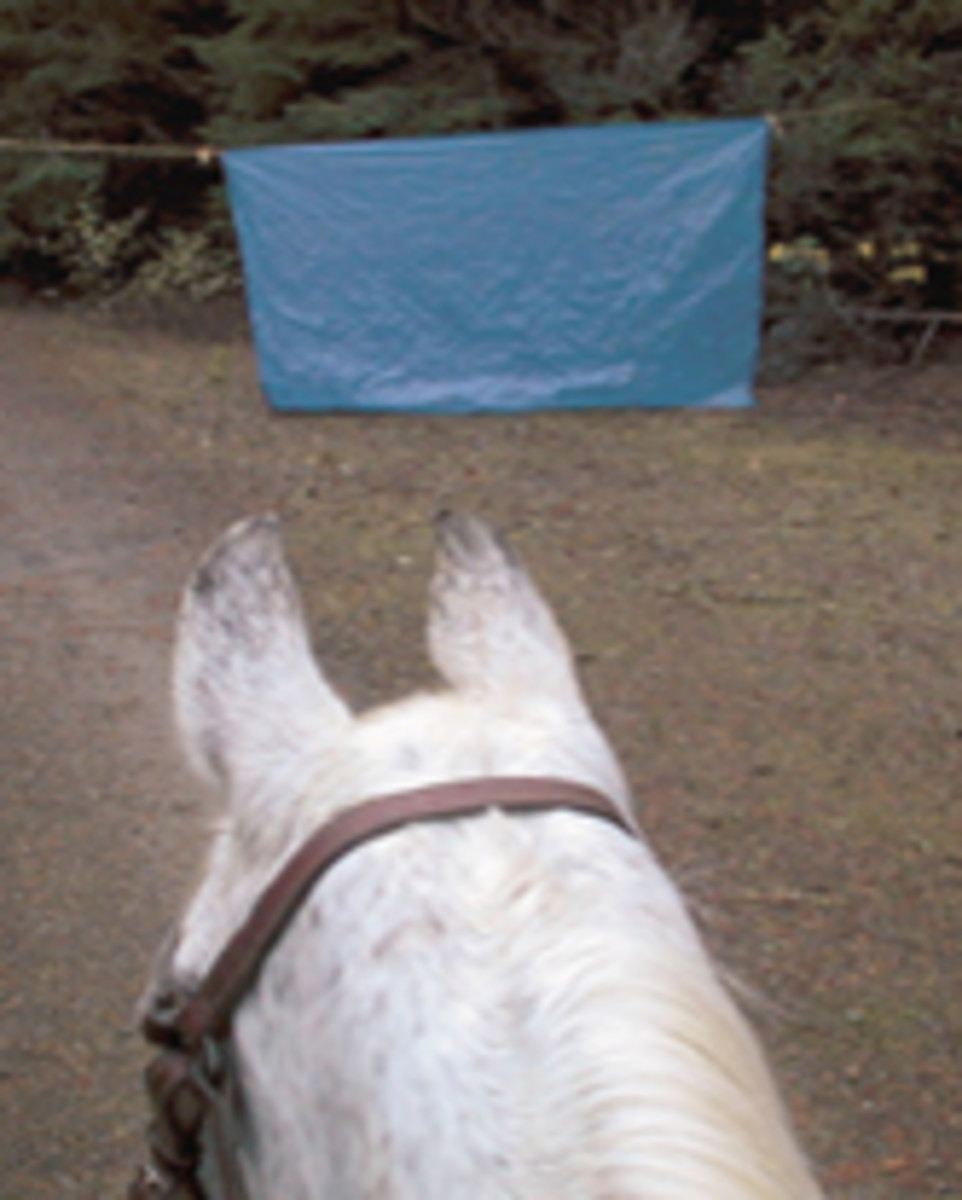
Riding-instructor’s tip: If you’re a confident rider, you’ll maintain a balanced, consistent seat position rather than reverting back to an old, less secure position. I agree that approaching things from the ground is a definite advantage, but sometimes older riders have difficulty remounting on the trail. If you need to, ask a helper to accompany you for this exercise to give you a boost.
Blue Tarp/Overhanging Object
Your horse’s view: This tarp is used to illustrate some scary situations that cause horses to flee, including overhanging branches or objects. Horses are claustrophobic by nature, and fear objects that could fall and injure them. At first, this mare is very curious. She thinks, That’s never been there before-what is it? Is it safe to approach or should I flee? When we get closer, she tenses up, ready to flee. She fears the overhanging rope holding the tarp. In her view, it’s not safe to walk under such a dangerous, dangling object.
Horse-trainer’s remedy: As with the brush pile, outfit your horse in a saddle, halter, and lead rope. Direct his attention to the tarp, and lead him up to it. He needs to know it won’t hurt him, which helps him trust you as a leader. Also lead him under the rope. If he’s still fearful, place tarps in the round pen or other enclosure to help desensitize him.
Rider’s view: This is a bit tougher situation for my mare. I definitely want to stay balanced, centered over her, and focused on what we’re doing.
Riding-instructor’s tip: When my mare’s attention leaves me, I pick up one rein to disengage her hindquarters and wait for her attention to get back onto me. To employ this technique, pick up one rein, and hold it until your horse steps under with his inside hindquarter, shifts his weight back, stops his forward motion, has a soft, responsive feel throughout, and brings his attention back to you. All of these elements must be in place before you continue. Just because my mare has stopped her forward motion doesn’t mean she’s mentally with me, waiting for my next move. Once she’s focused on me, I’ll use the “advance and retreat” method-taking her as close as I can comfortably go, then backing off for a moment-until she feels comfortable. Remember to breathe.
Water Crossing
Your horse’s view: Your horse’s eyes are on each side of his head, which creates poor depth perception; he can’t judge water depth. Not knowing the depth makes him nervous. Standing next to the water is okay, but in his mind, that creek or pond could pose a threat. In the wild, the water hole is where predators wait to catch a horse off guard.
Horse-trainer’s remedy: Outfit your horse in a halter, longe line, and saddle. Keep the bridle handy. Find or make a mud puddle, then send your horse around you on the line. Gradually reposition yourself so that the mud puddle becomes part of the circle. Continue sending him through the puddle in both directions until the exercise becomes easy and he relaxes. Then mount up, and approach the mud puddle from different angles. Next, approach deeper water, and use the “advance and retreat” method, described earlier. Relax, and enjoy feeling your horse getting comfortable with a water crossing.
Rider’s view: I’ve known several horses that splash or paw the water on their first water crossing. A couple of them have even lain down on their riders. Be aware that your horse might do this; don’t let his splashing and pawing carry on. Get him moving, even if it’s back to where you started. Going back will simply give you another opportunity to practice your approach.
Riding-instructor’s tip: A horse that’s a pro at water crossing would help in this situation. First use the “advance and retreat” method, described earlier. Accustom your horse to water until he’ll approach it, and maybe put in his feet. Then ask a riding buddy on a water-confident horse to cross the water first. You’ll probably still have to “advance and retreat,” but your horse will feel more confident when he sees his buddy wasn’t washed away or attacked by a predator.
On the Road
Your horse’s view: When your horse sees a car or truck coming at a high speed toward him, the noise scares him, the wind created by the passing car scares him, and the quick movement also scares him. He feels threatened. Anything that attacks a horse in the predator world does a straight-line attack. The car triggers your horse’s flight instinct, because maybe, like a predator, it’s coming at him-and coming fast.
Horse-trainer’s remedy: If your horse isn’t mentally and emotionally prepared for traffic, he isn’t safe on a road. Your life and freedom from injury depends on how well you train him to deal with traffic. I live on a two-mile lane with moderate traffic. I tack up a new horse with a halter and lead rope and lead him two-tenths of a mile along this road. He soon gets used to cars going by. After a couple weeks of leading him along the road and riding elsewhere, I stand in the stirrup and let him pack me along the road. I’m balanced over the saddle but not setting in it. Try to find a similar road in your area, and continue this process until your horse feels comfortable with moving vehicles.
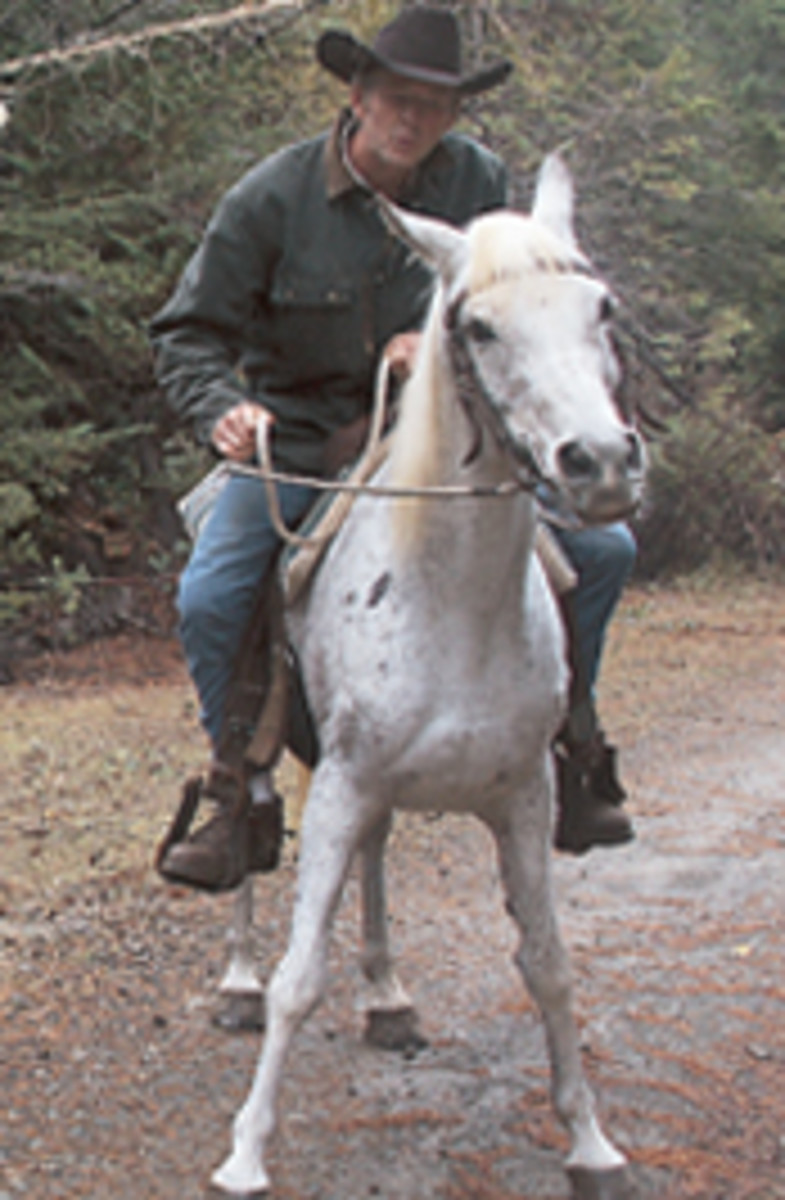
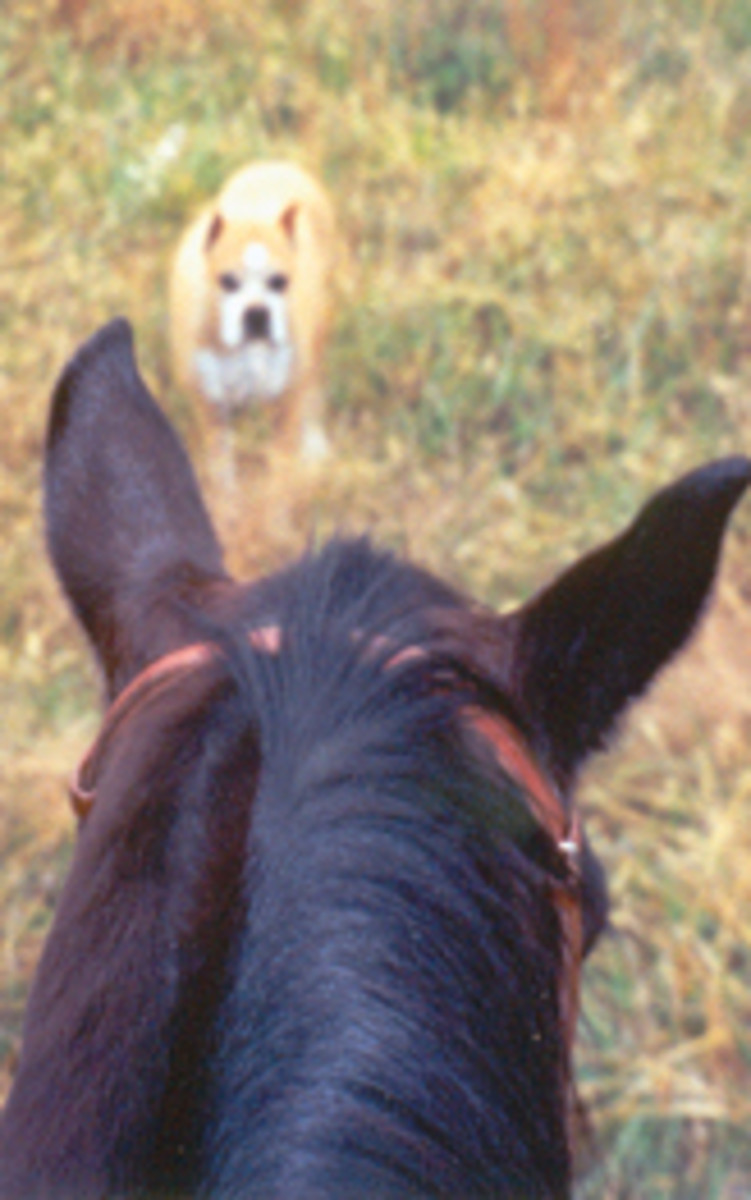

Rider’s view: I want to stress that in all of these scenarios it’s just as important to be in tune with your own feelings as your horse’s. Many people think they need to “gut it out” or be tough when they’re really nervous or scared. This isn’t in the best interest of your horse or yourself, and such an attitude can actually cause a dangerous situation.
Riding-instructor’s tip: Preparation-described at left-is of utmost importance. I’d also recommend riding only on roads that have an “escape route” should traffic approach. A road with field access is ideal. Or, simply ride alongside the road in the field, then slowly work toward the road as you and your horse feel more comfortable.
Approaching Dog
Your horse’ view: Dogs are predators to your horse; Mother Nature kicks in and tells him to be cautious. When he sees a dog on the trail, he’ll usually stop and tense up. As a prey animal, safety is number-one on his instinct list. Your horse would be brave to approach this dog.
Horse-trainer’s remedy: Try to get your horse used to dogs back at the barn. Allow dogs to run outside the round pen or arena as you work him. Then take a dog or two with you on the trail, if possible. Your horse will start to see that dogs are companions, not threats. If a strange dog approaches you on the trail and your horse starts to panic, get off, and let the dog approach you. This will let your horse see that he’s safe with you. Horses look for herd leaders, and if you provide them safety, they’ll give you their trust and confidence.
Rider’s view: When a dog approaches me, and I realize this is a problem for my horse, I often will call to the dog to see if I can get a friendly gesture from him-a tail wag, etc. I don’t know whether a horse recognizes this behavior as non-threatening or not, but it makes me feel better when a strange dog is approaching me with a wag and a smile. When I relax, my horse relaxes. But this technique can work against me if the dog comes running up for attention toward my frightened horse.
Riding-instructor’s tip: If your horse still dislikes the approach of an animal, use the one-reined stop described earlier, and wait for his mind to get back in tune with you. Breathe evenly, maintain your seat position and do things that help you stay calm. If the dog is with a handler, ask the handler to hold the dog until your horse is more comfortable. TTR






